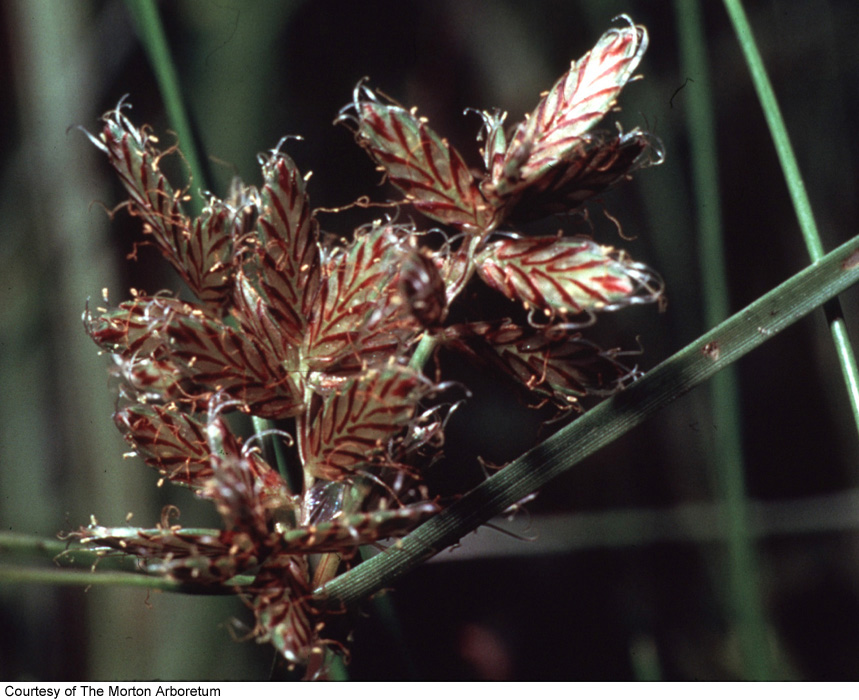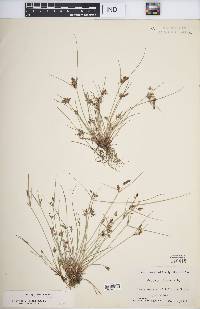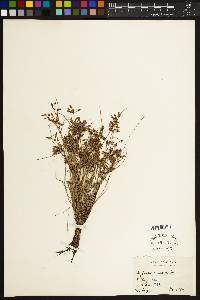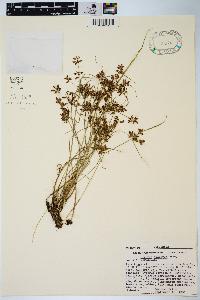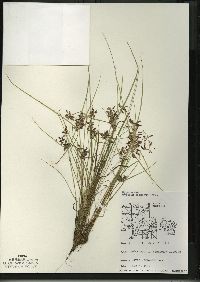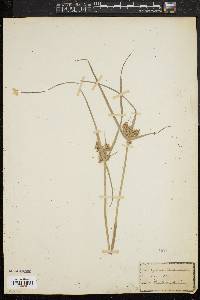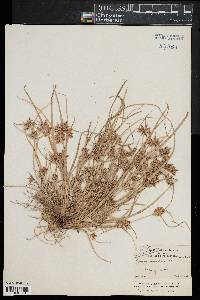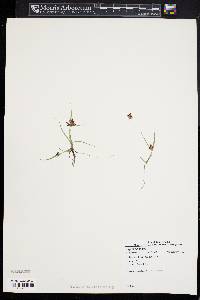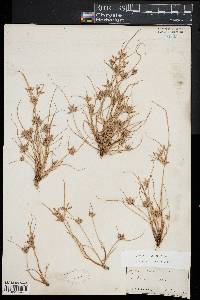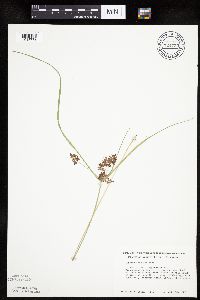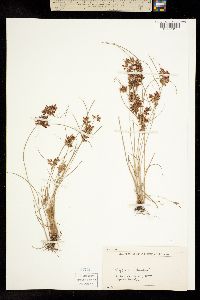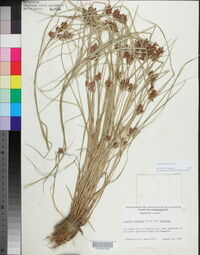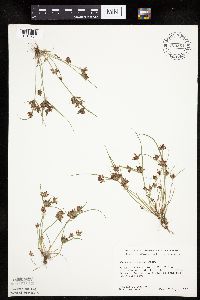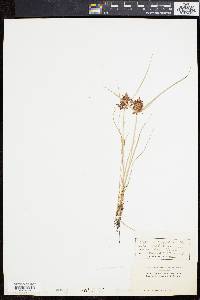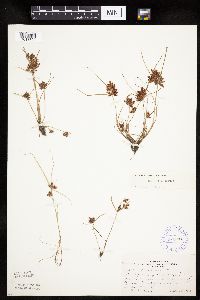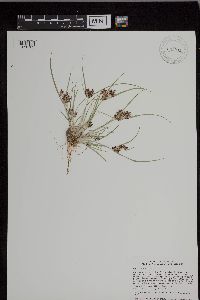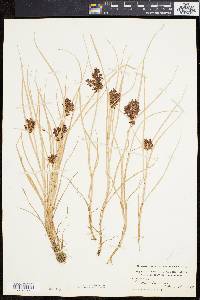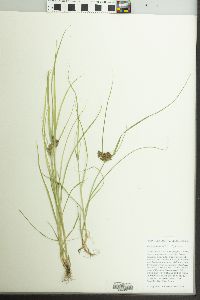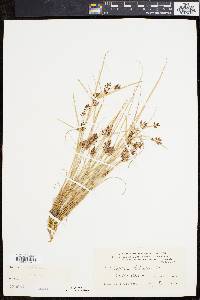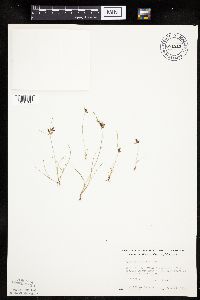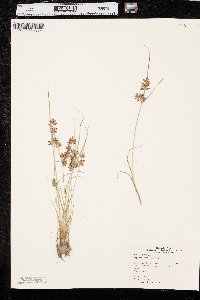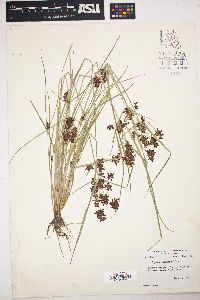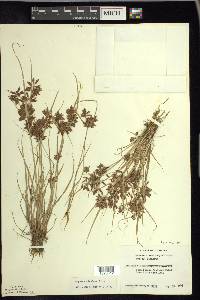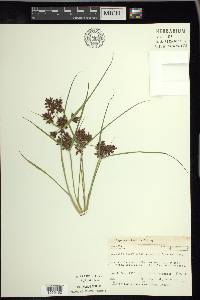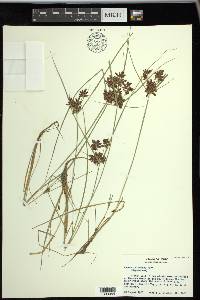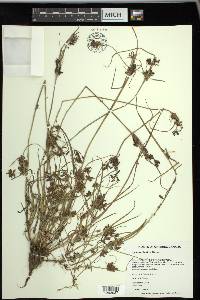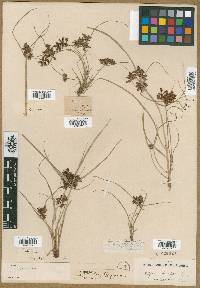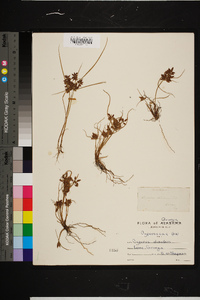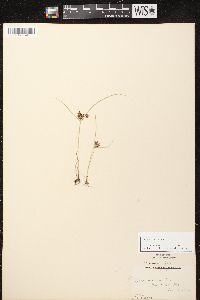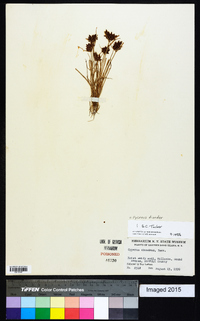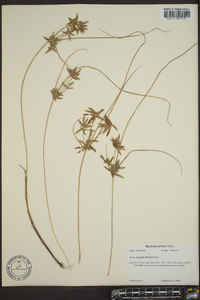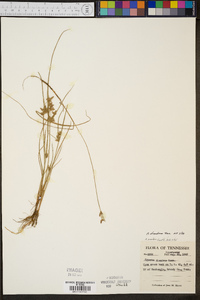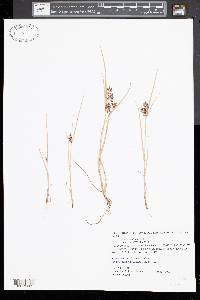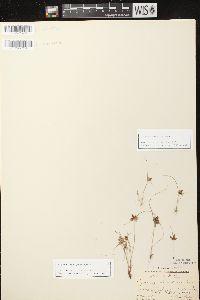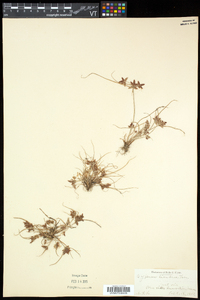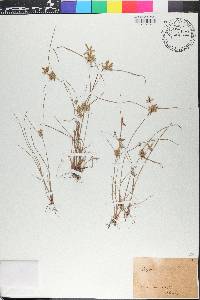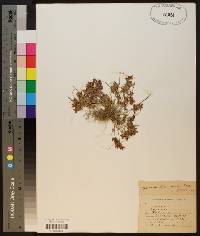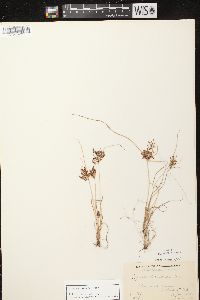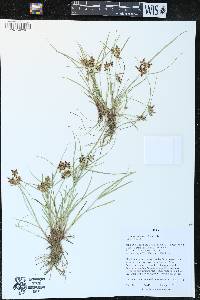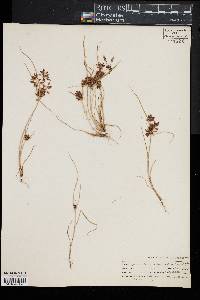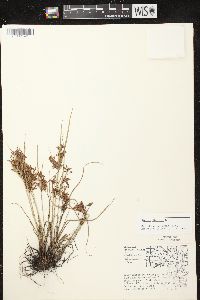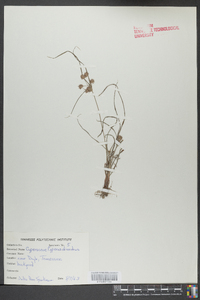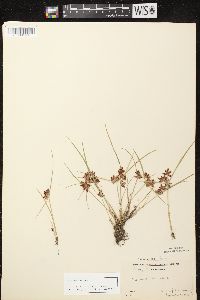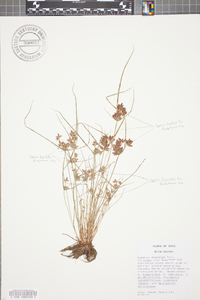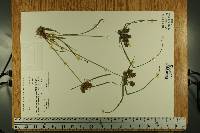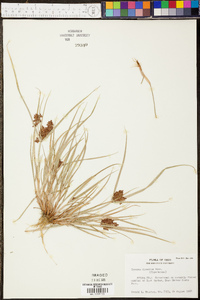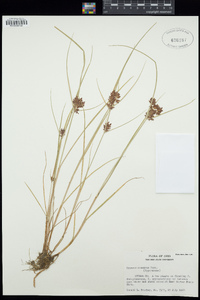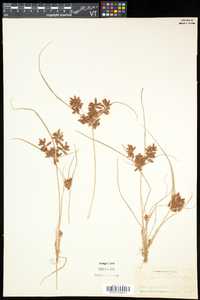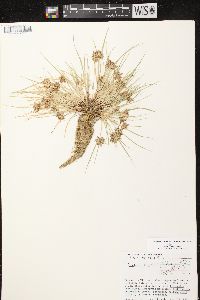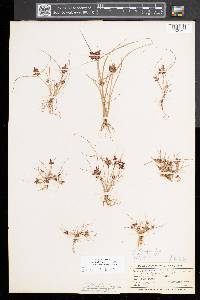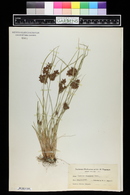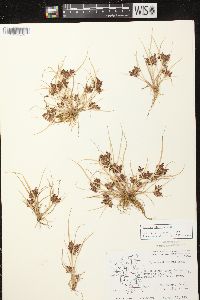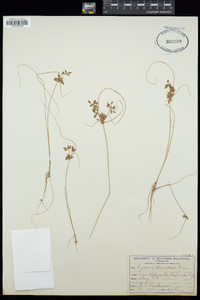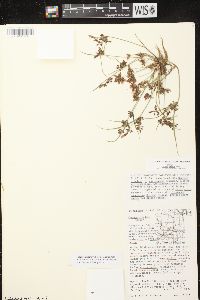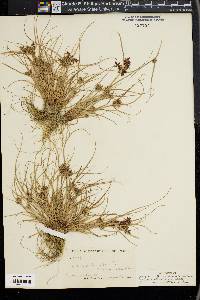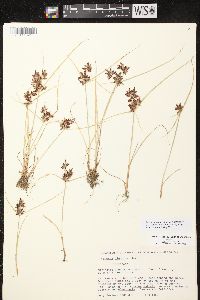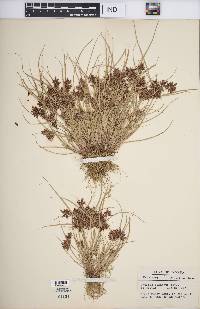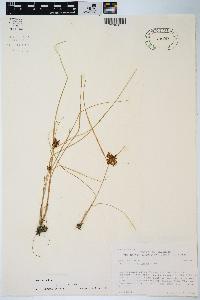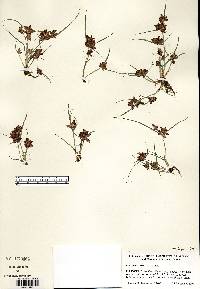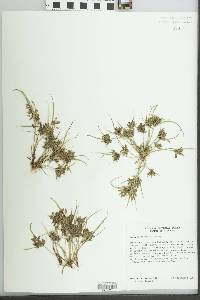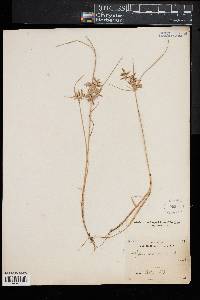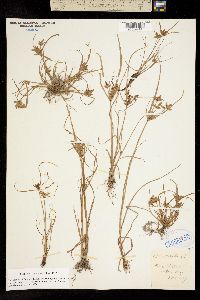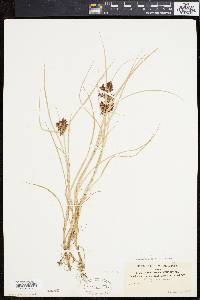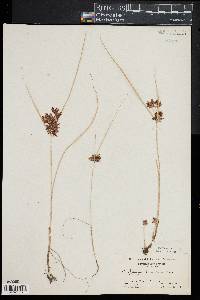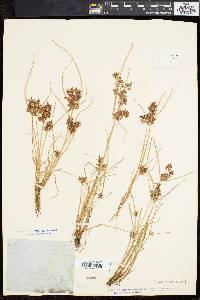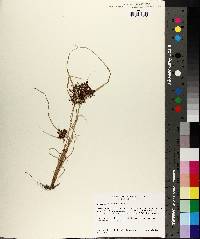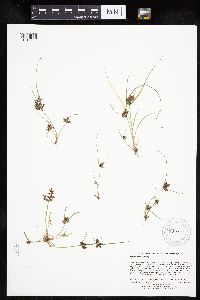
|
|
|
|
Family: Cyperaceae
Umbrella Flat Sedge, more...umbrella flatsedge
[Cyperus diandrus f. elongatus (Britton) Fernald] |
Herbs, annual, cespitose, with fibrous roots. Culms trigonous, 4-25(-35) cm, glabrous. Leaves flat, 5-20 cm × 1.5-3 mm. Inflorescences: heads ± digitate, 12-22 mm diam.; rays 3-6, 1-6 cm; bracts 1-4, ± horizontal, flat, 1.5-15 cm × 1.5-3 mm. Spikelets 6-12, oblong-lanceoloid, compressed, 5-10 × 2.8-3.2 mm; floral scales 8-28, closely imbricate, stramineous to light brown or clear (marginal band bright red, spikelet thus appearing dark margined), laterally ribless, oblong to ovate, 2.5-3 × 1.6-1.9 mm. Flowers: stamens 2(-3); anthers 0.3 mm, connective apex reddish, subulate, 0.1-0.2 mm; styles 0.3-0.5 mm; stigmas 2.2-3.1 mm. Achenes brown, network of ridges forming isodiametric or square cells, sessile or stipitate, obovoid to ovoid, 1-1.2 × 0.5-0.6 mm, stipe, if present, 0.1 mm, apex obtuse, apiculate, surfaces minutely punctate. Fruiting summer. Emergent shorelines, in sandy, peaty, or slightly brackish areas (though seldom where disturbed); 0-600 m; N.B., N.S., Ont., Que.; Conn., Del., Ill., Ind., Iowa, Maine, Md., Mass., Mich., Minn., Mo., Nebr., N.H., N.J., N.Y., Pa., R.I., Vt., Va. Annual herb with fibrous roots, tufted 1 - 25 cm tall Leaves: alternate, 5 - 20 cm long (often equal to culm), 1.5 - 3 mm wide, flat, linear, parallel-veined, keeled beneath, with a sheathing base that encloses the stem. Inflorescence: consisting of terminal spikelet heads, subtended by spirally arranged leafy bracts. Bracts one to four, more or less horizontal, unequal, 1.5 - 15 cm long, 1.5 - 3 mm wide, flat. Rays (branches of inflorescence) one to six, 1 - 6 cm long, unequal. Spikelet heads 1 - 2 cm in diameter, more or less palmate, consisting of six to twelve spikelets. Flowers: minute, in the axil of a floral scale, lacking sepals and petals. Stamens two (sometimes three), exserted. Anthers under 0.5 mm long. Pistil one. Style to 0.5 mm long, two-cleft nearly to the base. Stigma 2 - 3 mm long. Fruit: a one-seeded achene, short-stalked or stalkless, brown, about 1 mm long and 0.5 mm wide, lenticular (lens-shaped) and egg-shaped or reverse egg-shaped with a small, slender point at the apex, tiny-dotted, with a network of ridges. Seed with a thin, non-adherent wall. Culm: 1 - 25 cm long, triangular in cross-section, solid. Spikelets: 0.5 - 1.5 cm long, 2 - 3.5 mm wide, compressed, oblong lance-shaped, subtended by two small bracts, with eight to twenty-eight floral scales. Scales spirally arranged and overlapping, straw-colored to light brown or colorless with a red marginal band, 2.5 - 3 mm long, about 2 mm wide, egg-shaped, lowest one empty. Similar species: No information at this time. Flowering: mid-August to late September Habitat and ecology: Uncommon. Found along the shores of streams and ponds where inundation has left little sediment remaining. Occurence in the Chicago region: native Etymology: Cyperus is the ancient Greek word for sedge. Diandrus means "with two stamens." Author: The Morton Arboretum Tufted annual (0.5)1-2(-4) dm; cauline lvs often equaling the stem, to 3 mm wide; bracts usually 3, the lowest to 15 cm; rays 1-3, to 6 cm; spikelets 6-10, 8-15 נ2-3.5 mm; scales ovate, 2.5-3 mm, as seen from the side in half-view over 3 times as long as wide and obscurely acuminate, at maturity red-purple at the tip and in a tapering marginal band almost or quite to the base that is separated from the midrib by a colorless furrowed strip; stamens 2 (or 3 in upper fls); achenes lenticular, elliptic- obovate, 1-1.3 mm; style cleft almost to the base, persistent. Wet ground, especially along shores; Me. and Que. to N.D., s. to Va. and Io. Gleason, Henry A. & Cronquist, Arthur J. 1991. Manual of vascular plants of northeastern United States and adjacent Canada. lxxv + 910 pp. ©The New York Botanical Garden. All rights reserved. Used by permission. From Flora of Indiana (1940) by Charles C. Deam Infrequent to rare. My specimens were found in wet, sandy soil on the borders of lakes and sloughs and in mucky soil in dried-up sloughs and in like habitats along streams. |
This project was made possible in part by the Institute of Museum and Library Services [MG-70-19-0057-19].
Powered by Symbiota

